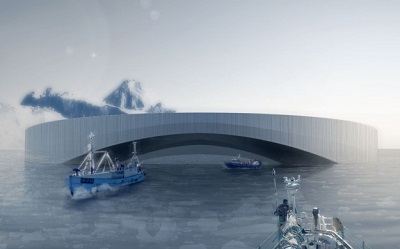Iceberg Wranglers Could Feed Greenland
A futuristic Arctic Harvester, that housed a small number of iceberg wranglers, has been designed to help feed the people of Greenland. The wrangler’s job would be to identify appropriately sized and stable icebergs in the immediate vicinity of the harvester, and then maneuver them to a conveyer belt using the towing techniques that are currently used to redirect icebergs that threaten offshore oil platforms.
Arctic Harvester was the First Prize winning entry in the Innovation and Architecture for the Sea category of the Jacques Rougerie Foundation International Architecture Competition, 2013. The development team consisted of: Meriem Chabani, Etienne Chobaux, John Edom and Maeva Leneveu from the École Nationale Supérieure d’Architecture Paris Malaquais (ENSAPM) in France.
It design proposes an itinerant soil-less agricultural infrastructure designed to drift the circulating ocean currents between Greenland and Canada, exploiting the nutrient-rich fresh water released by melting icebergs as the basis for a large-scale hydroponic-farming system.
 The floating facility is equipped to house a community of 800 people, inspired in its compact urban form by vertically oriented, bayside Greenlandic villages and their social, cultural and economic relationship to the sea. Arranged in a circular form, the Harvester delivers icebergs into its central bay, from which the harvested fresh water is directed to the hydroponic farming levels, and later to the osmotic energy plant in a process that values and retains fresh water as a re-usable resource. The central bay is thus the heart of the Harvester’s agricultural process, the center of its sustainable energy production, as well as an ice garden, offering social spaces and floating communal greenhouses for use by the inhabitants.
The floating facility is equipped to house a community of 800 people, inspired in its compact urban form by vertically oriented, bayside Greenlandic villages and their social, cultural and economic relationship to the sea. Arranged in a circular form, the Harvester delivers icebergs into its central bay, from which the harvested fresh water is directed to the hydroponic farming levels, and later to the osmotic energy plant in a process that values and retains fresh water as a re-usable resource. The central bay is thus the heart of the Harvester’s agricultural process, the center of its sustainable energy production, as well as an ice garden, offering social spaces and floating communal greenhouses for use by the inhabitants.
The icebergs collected would not be stopped from melting, or their rate of melt increased. Within the design of the Arctic Harvester, the idea is to allow a natural course of melting inside the central bay that gathers and redistributes the collected fresh water. The vessel as a whole is designed to drift with the currents that carry the icebergs during the course of their lives, often circling on the ocean currents between Greenland and the coast of Labrador for up to two years, before heading south past the east coast of the United States.
The project was instigated as a response to Greenland’s agricultural dependence, requiring the importation of almost all of required fresh fruit and vegetables from its less climatically and soil-fertility challenged neighbors. The solution proposed seeks not only to provide for that need, but also to be a reproducible model that, in the future, could swing Greenland’s balance of trade in this sector from deficit to surplus.
Chabani has been pleasantly surprised with the interest that has been shown in the project, and the group has been offered the opportunity to meet with specialists in various fields relevant to the project. They have also been invited to be involved with Polarisk Analytics, an international political risk research consultancy dedicated to analysis of geo-political issues and geo-economic prospects in the Polar Regions. “Three members of our team have formed the urban strategies department there, and we are excited at the prospect of developing the Arctic Harvester and other similar projects in the future with the experts at Polarisk,” says Chabani. “The first step of this collaboration is the development of a new in-depth version exploring, with more precision, the viability of the project. Our ideal from the start was to explore ways to develop small-scale prototypes of the various systems that make up the Arctic Harvester, and we are hoping to find investment and the opportunity for further exchange with experts in the field to push the project forward.”
